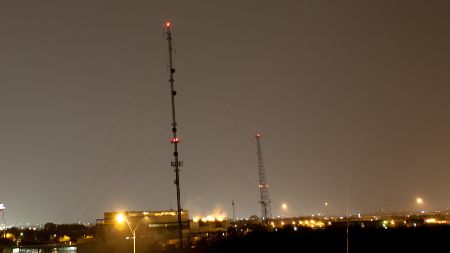by Larry
March, 2017How To Save MillionsBirds accidentally flying into communication antennae, mostly at night, account for "Towerkill." In the U.S. alone, estimates of those dying annually in this way range from 5 to 50 million. Birds near towers die in a variety of ways. Some do not see the guy wires that help support and stabilize the framework. Others lose their navigation sense due to the effects of nocturnal illumination. Thus disoriented, they may circle the towers repeatedly, even smashing into other fowl. They also of course hit the tower superstructures in large numbers. It is unknown just how artificial lighting disrupts birds' direction-finding, but the results are real enough. A Michigan Department of Natural Resources project noted that over 2300 birds were killed at a single tower in one night. Large numbers of the bird deaths occur among endangered species. Roughly 9% of yellow rails, for instance, are killed each year by collisions with the towers. 97% of tower related deaths are songbirds, especially warblers.
For vast numbers of bird deaths, a solution exists. Studies have shown that up to 70% of avian mortality would be eliminated if steady tower lights were changed to blinking red lights. The Federal Aviation Administration, meanwhile, has confirmed that blinking lights would not keep pilots from noticing the towers. The change would make economic sense as well, for operators of tall communication antennae currently must spend substantial time and money in extra maintenance incurred from collisions between birds and the broadcast or cell phone towers. Thanks to such findings, the FCC in 2015 altered its regulations to mandate that new towers be illuminated only with flashing lights. Older towers, by far the majority, were not affected by the requirement, but it was permitted that they be changed to the new lighting arrangements too. Volunteers as well as FCC employees are now going to the folks who run these older antennae and encouraging the transition to more bird-friendly tower lighting, in the process saving much in maintenance overhead and millions of avian lives.
Primary sources: |
 To help pilots avoid collision with them, the Federal Communication Commission (FCC) generally requires such lighting on towers above 199 feet. Many reach 1000 feet into the air. Shorter towers as well must have lighting in the proximity of airports. Well over 100,000 such high antennae exist in this country. Many thousands more are added annually.
To help pilots avoid collision with them, the Federal Communication Commission (FCC) generally requires such lighting on towers above 199 feet. Many reach 1000 feet into the air. Shorter towers as well must have lighting in the proximity of airports. Well over 100,000 such high antennae exist in this country. Many thousands more are added annually.